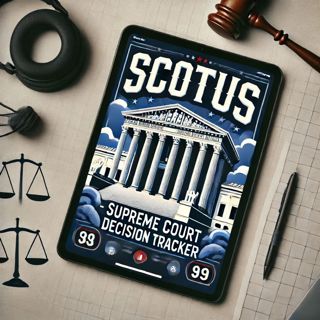
Supreme Court Showdown: Executive Powers and Election Law Battles Ahead
Over the past several days, the US Supreme Court has remained at the center of political and legal headlines, particularly focused on presidential removal powers and high-stakes cases scheduled for the upcoming term.A major development involves the continued fallout from President Trump's decision to remove Federal Trade Commissioner Rebecca Slaughter without statutory cause, prompting an ongoing legal battle. Lower courts ordered Slaughter's reinstatement, citing longstanding Supreme Court precedent, specifically the 1935 decision in Humphrey’s Executor v. United States, which ruled that the President cannot remove FTC Commissioners at will but only for cause. Even as the government sought an emergency stay of this decision, the DC Circuit denied the request, explicitly referencing that Supreme Court precedent remains binding and that recent high court decisions reaffirm that removal protections are still fully in effect unless the Supreme Court announces otherwise. These moves underscore an intensifying debate over the limits of executive authority and the independence of federal regulatory bodies.Listeners should note that these removal disputes are part of a broader wave of emergency applications before the Supreme Court, with the government repeatedly asking the justices to stay lower-court rulings that bar presidential firings or policy changes. For instance, recent filings include cases about the President’s power to fire Federal Reserve Board members and to rescind major foreign aid appropriations, with Chief Justice Roberts selectively granting administrative stays or simply requesting responses without granting immediate relief, signaling a nuanced and case-specific approach.Looking ahead to the Supreme Court’s new session, significant cases are poised to shape the country’s legal and political landscape—particularly those related to upcoming elections and federal power. The court has scheduled oral arguments for Bost v. Illinois, which examines whether federal candidates can challenge state rules for federal elections, a case that could open the door to broader election law disputes. Additionally, hearings are scheduled for challenges to President Trump’s tariffs under the International Emergency Economic Powers Act, adding to a docket already filled with crucial disputes over executive action and congressional authority.Another major headline concerns the Supreme Court’s engagement with voting rights and redistricting. A group of Louisiana voters is urging the court to strike down parts of the Voting Rights Act, questioning the constitutionality of creating additional majority-Black congressional districts. The outcome of this case could have broad consequences for how districts are drawn and minority representation in Congress.As the Supreme Court prepares for oral arguments and processes emergency requests at a rapid pace, the larger debate over its independence from Congress continues to swirl. Commentary in outlets like SCOTUSblog reminds listeners that, even amid controversies and calls for court reform, Congress retains significant control over the functioning and jurisdiction of the Supreme Court, shaping the everyday workings of the judiciary at the highest level.Thank you for tuning in and don’t forget to subscribe for the latest courts coverage and legal analysis. This has been a Quiet Please production, for more check out quiet please dot ai.For more http://www.quietplease.aiGet the best deals https://amzn.to/3ODvOtaThis content was created in partnership and with the help of Artificial Intelligence AI
22 Sep 3min

Supreme Court Rulings Strengthen Free Speech, Safeguard Federal Agencies
Listeners, there have been several major developments surrounding the US Supreme Court over the last three days. The biggest headline is the Court's unanimous decision in National Rifle Association of America v. Vullo, announced on September 19. Justice Sonia Sotomayor wrote for the Court, declaring that government officials cannot use threats or coercion to pressure private entities to suppress speech that the government disfavors. This ruling stems from accusations by the NRA that New York’s financial regulator pressured insurance companies and banks to cut ties with the group as a way to stifle its advocacy. Importantly, the Supreme Court stopped short of deciding whether a First Amendment violation had actually occurred, but found the NRA’s claims plausible enough to allow their lawsuit to move forward. Legal experts suggest this decision could set a strong precedent for broadcasters and media organizations if they challenge similar government actions in the future.There has also been significant judicial attention outside the Supreme Court, touching on the power and independence of federal commissions. According to the US Court of Appeals for the DC Circuit, President Trump’s recent removal of Federal Trade Commissioners Rebecca Slaughter and Alvaro Bedoya without statutory cause was ruled unlawful, with the district court ordering Slaughter’s reinstatement. The government tried to block her return pending appeal, but the appellate court dissolved the stay, emphasizing that Supreme Court precedent dating back to Humphrey’s Executor v. United States continues to bar presidents from firing Federal Trade Commissioners at will. The Supreme Court’s reaffirmation of these protections in recent decisions means Slaughter remains in her role for now, barring a change in Supreme Court direction.Listeners should also be aware of the ripple effects these Supreme Court decisions are having across the legal and political spectrum, particularly in First Amendment and executive authority spheres. Commentators are highlighting increased judicial scrutiny on government efforts to remove or sideline officials and the lasting protections given by longstanding Supreme Court precedent.Thanks for tuning in, and don’t forget to subscribe. This has been a quiet please production, for more check out quiet please dot ai.For more http://www.quietplease.aiGet the best deals https://amzn.to/3ODvOtaThis content was created in partnership and with the help of Artificial Intelligence AI
21 Sep 2min

Supreme Court Showdown: High-Stakes Tariffs and Power Struggles to Define the Next Term
Listeners, the latest headlines from the US Supreme Court center around an upcoming blockbuster case on November 5, when the justices will hear arguments over the legality of former President Donald Trump’s global tariffs. This dispute, triggered by Trump’s invocation of emergency powers under the International Emergency Economic Powers Act, challenges the extent of presidential authority to set sweeping tariffs on imports. The Federal Circuit recently ruled that Trump overstepped his authority, siding with 12 state attorneys general who argued the tariffs hurt consumers and businesses. Tariffs remain in place for now, but the Supreme Court’s decision could reshape the balance of power between Congress and the White House on trade policy.Looking at broader Supreme Court news, experts at the Committee for Economic Development of The Conference Board highlight that the upcoming Term—starting the first Monday in October—will be packed with consequential cases beyond the tariffs issue. Major questions about the separation of powers, including redistricting, the right to counsel, workforce protections, copyright, and other topics directly impacting business, are on the docket. Business leaders and policymakers are watching closely, as outcomes could send ripples through government policy and the economy.Another closely watched legal maneuver involves the Federal Reserve. President Trump recently filed an emergency appeal to the Supreme Court seeking permission to remove Fed board member Lisa Cook. Lower courts blocked her removal, citing due process violations, and the administration has escalated the matter in hopes of overturning those rulings. The ongoing dispute underscores mounting political pressure on the Fed’s independence, especially as rate cuts and economic policy adjustments remain in the headlines.Listeners should also be aware of growing legal and political clashes over the First Amendment. Media companies, facing lawsuits and political pressure from the Trump administration, are being criticized for capitulating on issues of free speech—most recently evident in CBS News’ settlement with Trump and the contentious cancellation of popular programming. Concerns are intensifying about the Court’s stance on press freedom and the changing landscape for government regulation of media.Thanks for tuning in, and don’t forget to subscribe. This has been a Quiet Please production, for more check out quietplease.ai.For more http://www.quietplease.aiGet the best deals https://amzn.to/3ODvOtaThis content was created in partnership and with the help of Artificial Intelligence AI
19 Sep 2min

Unprecedented Supreme Court Shadow Docket Usage Raises Transparency Concerns
Major news regarding the U.S. Supreme Court in the last three days centers on the ongoing debate over the Court’s use of its so-called shadow docket, which has reached unprecedented levels in the current term. The shadow docket, traditionally reserved for routine, procedural matters, is now being used far more frequently and for more consequential rulings—often without detailed explanations or disclosure of how individual justices voted. According to SCOTUSblog, the number of emergency matters on the shadow docket has soared from 44 in the previous term to 113 in the current one as of late June, reflecting a dramatic increase under the new presidential administration. Legal experts and commentators, including those quoted in The IE Voice, warn that this trend risks further eroding public confidence in the Court’s transparency and impartiality, especially as the shadow docket is increasingly used for decisions that have significant policy and civil rights implications, such as immigration enforcement and other regulatory actions.Attention has also been drawn to how these emergency rulings, often delivered without full briefing or oral arguments, can leave lower courts and federal agencies uncertain about the reasoning behind the Court’s decisions. Critics argue that this practice undermines the usual process of judicial review and accountability, making it harder for the public to understand or challenge the Court’s actions. The broader concern is that expanded use of the shadow docket contributes to the perception that the judiciary is becoming less transparent and more politically influenced at a time when the balance of power among the three branches of government is already under scrutiny.Looking ahead, the Supreme Court will soon consider a request from the National Basketball Association regarding the Video Privacy Protection Act, with briefing scheduled to conclude and arguments potentially to follow in the coming weeks. This case could have important implications for digital privacy and the scope of protections under federal law, though no decision has been announced as of the last three days.Thank you for tuning in for this quiet please production. For more, check out quiet please dot ai.For more http://www.quietplease.aiGet the best deals https://amzn.to/3ODvOtaThis content was created in partnership and with the help of Artificial Intelligence AI
17 Sep 2min

Supreme Court Sparks Controversy with Landmark Immigration Ruling
During the past few days, the US Supreme Court has captured headlines with a deeply contentious emergency order in the Noem v. Vasquez Perdomo immigration case. On September 8, the Court granted the federal government’s request to pause a lower court ruling that had blocked aggressive immigration raids in Los Angeles. These raids involved armed federal agents detaining people, often based on perceived race, language, and type of employment, raising significant concerns over constitutional rights and equal treatment. Justice Kavanaugh’s concurrence argued that factors like language and job type could be relevant for agents to develop reasonable suspicion, particularly in areas with high numbers of undocumented immigrants. By contrast, Justice Sotomayor, joined by Justices Kagan and Jackson, issued a forceful dissent, warning that the Court’s decision effectively sanctioned discriminatory police tactics and created risks for millions of innocent Latino workers and Spanish speakers.This ruling has immediate implications for immigrant communities and citizens alike, as federal agents are now able to continue raids using disputed criteria while the legal battle continues. The Ninth Circuit Court of Appeals is set to hear arguments on this issue soon, meaning the Court’s emergency stay may precede a more substantial review. Legal experts and advocacy groups have also pointed to the broader trend of the Supreme Court relying on emergency rulings, labeled the “shadow docket,” which often circumvent traditional argument and deliberation.In addition, there’s renewed scrutiny on the Supreme Court’s growing role in expanding executive powers, with critics arguing recent interventions frequently bolster federal government authority and narrow paths for individuals to hold agents accountable for wrongdoing. Notably, Justice Kavanaugh has been a focus of public protests, especially at a Texas event where demonstrators rebuked his past votes and the Court’s controversial ruling granting broad presidential immunity last year. Survey data from Gallup recently revealed that the Supreme Court’s approval rating slid to a new low of 39 percent, indicating rising public distrust and sharp partisan divides over its decisions.Looking ahead, listeners can expect further decisions on major issues including tariffs, immigration, federal spending, and executive authority—especially as high-profile cases around former President Donald Trump’s actions are docketed for review. For now, the Court’s latest rulings underscore its decisive impact on national policy, civil rights, and the evolving balance of power in American government.Thanks for tuning in, and don’t forget to subscribe. This has been a quiet please production, for more check out quiet please dot ai.For more http://www.quietplease.aiGet the best deals https://amzn.to/3ODvOtaThis content was created in partnership and with the help of Artificial Intelligence AI
15 Sep 2min

Supreme Court Reshapes Immigration Enforcement and Presidential Powers
The US Supreme Court has made major headlines in the past several days, starting with a controversial decision that drew strong reactions from immigrant rights groups. On Monday, the Court's conservative majority used a shadow docket ruling to allow federal immigration officials to reinstate practices that many civil rights advocates have described as enabling discriminatory and even racist tactics. According to Immigrants Rising and reporting from TIME, this means agents can now stop suspects based on race, language, or occupation while broader legal challenges continue, particularly impacting communities in Los Angeles and igniting protests from organizations concerned about racial profiling and abuse.While the Supreme Court's decision on this matter is not final, it does clear the way for such enforcement practices to resume immediately, at least until further hearings later this month in the lower courts. Advocates are preparing to contest the decision vigorously, and the outcome could shape immigration enforcement practices across the country in the near future.On another front, the Court has moved quickly to address the legal limits of presidential emergency powers, agreeing this week to hear a high-profile challenge to former President Donald Trump's authority to impose sweeping tariffs under the International Emergency Economic Powers Act, known as IEEPA. After an August ruling by the US Court of Appeals for the Federal Circuit struck down Trump's emergency tariffs—saying the Act did not grant the president such sweeping authority—the government immediately appealed for Supreme Court review. The high court has responded with rare urgency, expediting the case and demanding all briefs be submitted by September 19, in preparation for in-person arguments set for early November. Small businesses and states challenging the tariffs argue that the president overstepped his constitutional and statutory limits, while the White House insists the tariffs are both lawful and necessary for national security and economic interests.These fast-moving developments highlight the Supreme Court's major influence over US immigration policy and the scope of presidential power. As high stakes cases land on the Court's docket, major policy and legal battles are set to play out in the coming weeks, watched closely by policymakers, interest groups, and the public.Thanks for tuning in, and don't forget to subscribe. This has been a Quiet Please production, for more check out quiet please dot ai.For more http://www.quietplease.aiGet the best deals https://amzn.to/3ODvOtaThis content was created in partnership and with the help of Artificial Intelligence AI
10 Sep 2min

Headline: Supreme Court Faces Intensifying Scrutiny Over 'Shadow Docket' and Executive Power Battles
A major focus right now at the Supreme Court is the intensifying scrutiny over its use of the emergency, or “shadow,” docket. According to NBC News and commentary on The Daily Beans podcast, ten federal judges have publicly criticized the Court’s increasing reliance on this emergency process, raising concerns about the lack of transparency and accountability in deciding high-stakes legal questions without full briefings or oral arguments. This rare move, involving sitting judges giving interviews, signals mounting tension and divided opinion throughout the federal judiciary.Meanwhile, attention is turning to an expedited Supreme Court case involving the Trump administration’s authority to impose broad national security tariffs under the International Emergency Economic Powers Act. The Federal Circuit found the tariffs unlawful, arguing that Congress had not clearly given the President such sweeping tariff power, and this decision is already causing international uncertainty and economic dislocation, as Reuters has reported. The administration and the opposing parties have agreed on a fast-tracked hearing schedule that could see briefs and oral argument take place before the end of the year, making this one of the most consequential cases currently before the Justices, with huge implications for executive power and U.S. economic policy.In addition, federal courts outside the Supreme Court have recently ruled against several of the administration’s controversial actions, including planned mass deportations, deploying the National Guard in American cities, and funding cuts to states and universities. These defeats are expected to make their way up to the Supreme Court, underscoring how the Court will soon be forced to address the legal boundaries of recent executive branch initiatives. SCOTUSblog indicates that the Trump administration is seeking alternative legal footing to maintain its policy priorities, confident that the conservative majority may ultimately side with executive authority.There’s also a spotlight on internal tensions within the judiciary, following recent public exchanges between Justice Neil Gorsuch and lower court judges about how binding the Court’s emergency orders truly are. Former Justice Stephen Breyer has emerged to defend a trial judge recently criticized by Gorsuch, describing him as honest and respectful of the Supreme Court, which both highlights and complicates the ongoing debate about judicial hierarchy and respect within the federal courts.To summarize, the Supreme Court faces pressure from both within the judiciary and the public to clarify its approach to the emergency docket and to rule on defining questions about presidential authority in trade and immigration. All of these developments suggest a period of unusual visibility, political stakes, and institutional debate for the highest court in the United States.Thanks for tuning in and don’t forget to subscribe. This has been a quiet please production, for more check out quiet please dot ai.For more http://www.quietplease.aiGet the best deals https://amzn.to/3ODvOtaThis content was created in partnership and with the help of Artificial Intelligence AI
8 Sep 3min

Supreme Court Turmoil: Immigration, Trade, and Emergency Rulings Spark Controversy
Listeners, the US Supreme Court has been at the center of several high-profile developments in recent days, with headline news focusing sharply on immigration, trade, and its own handling of emergency cases. Federal courts are clashing over Trump-era immigration policies, particularly the fate of protections for Venezuelans and Haitians under Temporary Protected Status, or TPS. This turmoil stems from the Trump administration's aggressive efforts to revoke these humanitarian protections for over a million people. A federal judge just blocked the administration’s move to end TPS for Haitians and Venezuelans, arguing the actions were unlawful and caused widespread harm through deportations and family separations. However, the Supreme Court earlier allowed the administration’s policy to take effect temporarily as the case continues, leading to chaos and uncertainty for thousands. Legal analysts from the ACLU and UCLA’s Center for Immigration Law note that many people have already suffered, with loss of work authorization, detainment, and removals before yesterday’s ruling restored protections, at least provisionally.On the trade front, a significant legal battle is playing out over President Trump’s sweeping tariffs, imposed under the International Emergency Economic Powers Act. A coalition of small businesses has asked the Supreme Court to intervene after a federal appeals court struck down these tariffs, arguing Trump exceeded his authority under current law. The tariffs, affecting numerous countries for alleged roles in the fentanyl crisis and violating trade reciprocity, have caused serious supply chain disruptions and economic strain, prompting urgent calls for Supreme Court resolution. Trump’s legal team is pushing for expedited review, claiming that these tariffs are essential for American economic security and global negotiating power. If the court upholds the lower court ruling, billions in tariffs could potentially be refunded, creating another wave of legal and financial complications.Meanwhile, some legal scholars and district court judges are openly frustrated by what they call the Supreme Court’s vague and often unexplained emergency rulings, especially on the so-called shadow docket. According to analysis from The New Republic, this approach has left district courts and litigants without clear guidance, undermining confidence across the judiciary. The tension is heightened by perceptions that the Court’s standards fluctuate depending on which administration is in power, fueling a broader debate about the integrity and impartiality of emergency Supreme Court decisions.As these matters unfold, the Supreme Court is under mounting pressure to clarify its position on executive authority, immigration relief, and its own process—a dynamic sure to shape the national legal landscape in the coming weeks. Thank you for tuning in. Be sure to subscribe for more updates. This has been a Quiet Please production, for more check out quiet please dot ai.For more http://www.quietplease.aiGet the best deals https://amzn.to/3ODvOtaThis content was created in partnership and with the help of Artificial Intelligence AI
7 Sep 3min





















